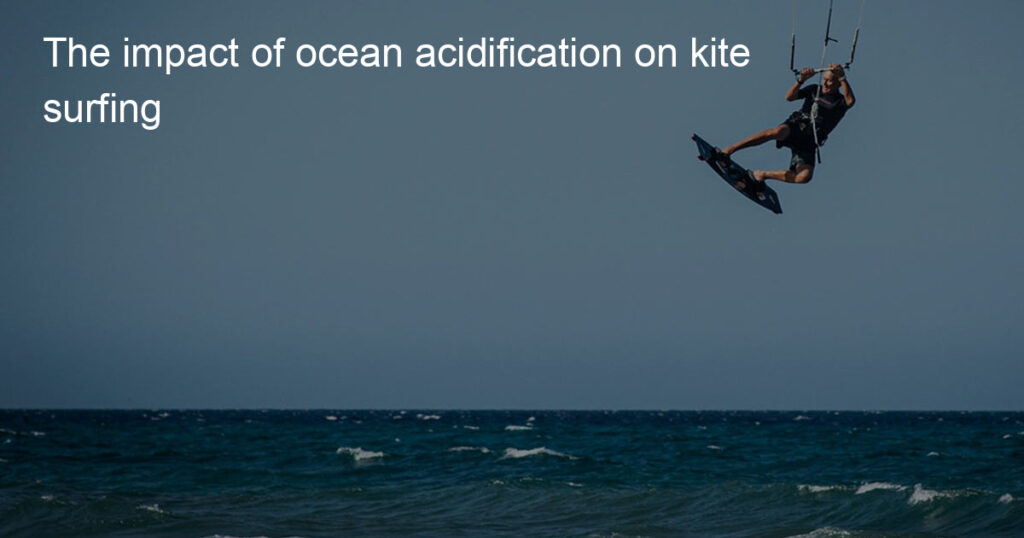For anyone who loves to spend time out on the water, kite surfing is a great way to get some exercise while admiring the beauty of nature. Whether you’re gliding over the surface of a glassy sea or tackling choppy waves, it can be an incredibly rewarding experience. Unfortunately, several environmental threats could have serious implications for this beloved sport – and one of them is ocean acidification.
What are the impacts of ocean acidification?
Ocean acidification is a real and serious problem. It’s caused by carbon dioxide (CO2) being released into the atmosphere and dissolving into the oceans, reducing the pH of the water and making it more acidic. This decrease in pH has multiple impacts on oceanic life, including coral bleaching, an increase in jellyfish populations, disruption to fish embryonic stages, destruction of oyster habitats, and changes in species distribution and abundance – to list just a few!
Scientists have already seen evidence of some negative effects on marine animals at higher CO2 levels than those present during preindustrial times. Sea creatures are particularly vulnerable to these changes since they cannot simply relocate like land animals can when their environment begins to change. The seriousness of this situation demands our attention and solutions must be found if we want to preserve our oceans for generations to come.
What activities cause ocean acidification?
It might surprise you to know that human activities are largely responsible for ocean acidification. The primary cause is the use of fossil fuels, which end up releasing carbon dioxide into the atmosphere and eventually into the ocean. Excess nitrate fertilizers used in agriculture also enter the ocean, while industrial processes and the burning of coal concentrate ozone close to the Earth’s surface and cause further acidification.
Little can be done to simply prevent these pollutants from entering a water system, meaning we must become more conscious of our actions when it comes to using fossil fuels, as well as how often we apply fertilizer. There is still hope, however; with initiatives such as reforestation projects helping reduce carbon dioxide levels and new regulations being constantly enforced by governments across the world, there is clear potential for us all to do our bit and make a contribution to saving our oceans from acidification.
What is most affected by ocean acidification?
Ocean acidification is a drastic and concerning decrease in the pH of our oceans’ waters. It has been linked to industrial emissions and other environmental factors, leading to an increase of carbon dioxide in the atmosphere which is then absorbed by the seas. The ocean’s fragile ecosystems are some of the most heavily affected components due to this process.
Marine life such as coral, shellfish, algae, and plankton have suffered detrimental losses when exposed to these acidic levels. This can reduce biodiversity due to their inability to survive at lower pH conditions and thus affects global food security since many commercial fisheries rely on these species.
Furthermore, extreme fluctuations in acidity can lead to detrimental effects on marine mammals like whales and dolphins who cannot acclimate fast enough when facing drastic changes in their habitats. It is clear that ocean acidification poses a global threat when left unaddressed but with concerted efforts, we still have a chance at reversing its steady progress.
How does ocean acidification affect waves?
The ocean is already a pretty powerful force, with waves that could range from peaceful ripples to violent storms. But recent research indicates that climate change may be making waves even more powerful. As the oceans absorb carbon dioxide, they become more acidic, which can cause them to expand and take up more space.
As the water level rises and increases the volume of water in the ocean, it has a trickle-down effect on things like wave intensity and frequency — making them bigger, more frequent, and potentially even more dangerous for any bathers or coastal regions nearby.
So while it may offer a temporary solution to rising global temperatures and sea levels, ocean acidification also carries some frighteningly real risks as far as wave power is concerned.
Concluding Thoughts
In a time when sea levels are rising and our climate is changing, it’s important to remember that activities like kite surfing can be impacted. Ocean acidification, essentially the acidification of Earth’s oceans due to carbon dioxide emissions, is hurting both our lifestyles and the environment. Not only does it make it harder for us to enjoy activities like kite surfing, but it can also have negative effects on wildlife and coral reefs.
The threat of ocean acidification demands attention and awareness, so we can find solutions to combat this environmental issue. We must continue to educate one another to achieve a greener future in that all species — human, and non-human — can thrive. With concerted efforts from individuals and governments alike, we might just be able to reduce localized ocean acidification in hotspots around the globe.
By taking measures such as following eco-friendly policies for offshore kiteboarding activities and reducing air pollution at its sources, we can protect one of our most beloved pastimes while also saving our precious planet for future generations.








